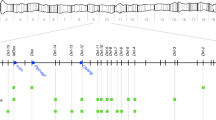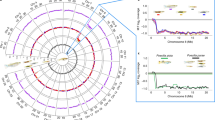Abstract
A CENTRAL paradigm in evolutionary biology is that sexual reproduction is advantageous over asexuality1–5. One of the long-term disadvantages asexual forms have to face is Muller's ratchet6. In the absence of recombination, theoretically no genotype can ever produce offspring with fewer mutations than its own load. The accumulation of deleterious mutations and gene combinations that cannot be purged should lead to extinction of parthenogenetic forms within 104–105 generations7,8. Evidence is accumulating, however, that some of these might have survived for such periods or even longer9–14. In the Amazon Molly fish Poecilia Formosa we have detected a process that appears to compensate for disadvantages of asexuality, namely incorporation of subgenomic amounts of DNA from a bisexual host species by microchromosomes.
This is a preview of subscription content, access via your institution
Access options
Subscribe to this journal
Receive 51 print issues and online access
$199.00 per year
only $3.90 per issue
Buy this article
- Purchase on Springer Link
- Instant access to full article PDF
Prices may be subject to local taxes which are calculated during checkout
Similar content being viewed by others
References
Williams, G. C. Sex and Evolution (Princeton Univ. Press, New Jersey, 1975).
Maynard Smith, J. The evolution of Sex (Cambridge Univ. Press, Massachusetts, 1978).
Bell, G. The Masterpiece of Nature (Univ. California Press, San Francisco, 1982).
Kondrashov, A. S. J. Hered. 84, 372–387 (1993).
Charlesworth, B. Trends Ecol. Evol. 4, 64–267 (1989).
Muller, H. J. Mutat. Res. 1, 2–9 (1964).
Lynch, M. & Gabriel, W. Evolution 44, 1725–1737 (1990).
Gabriel, W., Lynch, M. & Bürger, R. Evolution 47, 1744–1757 (1993).
Schartl, M. et al. Proc. natn. Acad. Sci. U.S.A. 88, 8759–8763 (1991).
Avise, J. C., Trexler, J. C., Travis, J. & Nelson, W. S. Evolution 45, 1530–1533 (1991).
Spolsky, C. M., Phillips, C. A. & Uzzell, T. Nature 356, 706–708 (1992).
Hedges, S. B., Bogart, J. P. & Maxson, L. R. Nature 356, 708–710 (1992).
Quattro, J. M., Avise, J. C. & Vrijenhoek, R. C. Proc. natn. Acad. Sci. U.S.A. 89, 348–352 (1992).
Schartl, M., Wilde, B., Schlupp, I. & Parzefall, J. Evolution (in the press).
Hubbs, C. L. & Hubbs, L. C. Science 76, 628–630 (1932).
Turner, B. J. in Mechanisms of Speciation (ed. Barigozzi, C.) 265–305 (Liss, New York, 1982).
Rasch, E. M., Monaco, P. J. & Balsano, J. S. Histochemistry 73, 515–533 (1982).
Schröder, J. H. Zool. Beitr. 10, 369–463 (1964).
Balsano, J. S., Rasch, E. M. & Monaco, P. J. in Ecology and Evolution of Livebearing Fishes (Poeciliidae) (eds Meffe, G. K. & Snelson, F. F. Jr) 277–297 (Prentice Hall, Englewood Cliffs, NJ, 1989).
Kallman, K. D. Genetics 50, 260–262 (1964).
Rasch, E. M. & Balsano, J. S. in Evolution and Ecology of Unisexual Vertebrates (eds Dawley, R. M. & Bogart, J. P.) Bulletin 466, 252–267 (New York State Museum, Albany, New York, 1989).
Sola, L., Rossi, A. R., Bressanello, S., Rasch, E. M. & Monaco, P. J. Cytogenet. Cell Genet. 63, 189–191 (1993).
Charlesworth, D., Morgan, M. T. & Charlesworth, B. Genet. Res. 61, 39–56 (1993).
Kondrashov, A. S. Genetics 137, 311–318 (1994).
Hubbs, C. Interactions between a Bisexual Fish Species and its Gynogenetic Sexual Parasite Bulletin 8 (Texas Memorial Museum, Austin, 1964).
Schlupp, I., Marler, C. & Ryan, M. J. Science 263, 373–374 (1994).
Vrijenhoek, R. C. in Speciation and its Consequences (eds Otte, B. & Endler, J. A.) 386–400 (Sinauer, Sunderland, 1989).
Vrijenhoek, R. C. in Evolution and Ecology of Unisexual Vertebrates (eds Dawley, R. M. & Bogart, J. P.) Bulletin 466, 24–31 (New York State Museum, Albany, New York, 1989).
Nanda, I. et al. J. molec. Evol. 30, 456–462 (1990).
Author information
Authors and Affiliations
Rights and permissions
About this article
Cite this article
Schartl, M., Nanda, I., Schlupp, I. et al. Incorporation of subgenomic amounts of DNA as compensation for mutational load in a gynogenetic fish. Nature 373, 68–71 (1995). https://doi.org/10.1038/373068a0
Received:
Accepted:
Issue Date:
DOI: https://doi.org/10.1038/373068a0
Comments
By submitting a comment you agree to abide by our Terms and Community Guidelines. If you find something abusive or that does not comply with our terms or guidelines please flag it as inappropriate.



